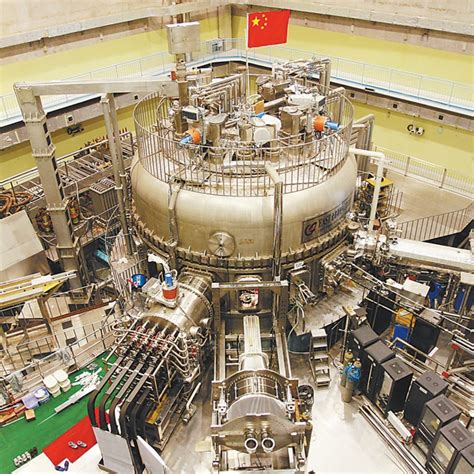The recent announcement that China’s HH70 has achieved first plasma is a notable milestone in the world of fusion energy. As the first high-temperature superconducting tokamak to do so, HH70 presents a technological advancement that has stirred both excitement and scrutiny within the scientific community. This achievement is particularly significant in that it showcases China’s growing capabilities in cutting-edge technological innovation. However, it’s crucial to contextualize this development within the broader landscape of fusion research, specifically when comparing it to other projects like SPARC in the United States.
Despite the fanfare, some experts argue that the milestone may be somewhat overstated. For instance, a critical comparison with the SPARC project reveals a stark difference in scale and power. The SPARC project boasts a major radius of 1.85 meters and a magnetic field strength of 12.2 Tesla, whereas HH70 is significantly smaller with a 0.75-meter radius and a 0.6 Tesla magnetic field. These comparisons highlight the fact that while HH70 is operational, it might not yet be the game-changer some expect it to be. The use of high-temperature superconducting magnets in HH70 has not yet resulted in the anticipated leap in performance metrics, casting some doubt on its immediate impact relative to other fusion reactors in development.
Another layer to this discussion revolves around the nature of funding and historical context. Over the past 50 years, the funding for fusion research has often been described as insufficient, if not outright ‘paltry.’ For instance, the U.S. budget for magnetic confinement fusion has been criticized for being below the level necessary to achieve substantial breakthroughs. A historical comparison of fusion budgets shows a significant disparity between the allocated funds and the ambitious timelines proposed in the past. This underfunding has inevitably led to delays and limited progress, making the milestones reached all the more impressive given the circumstances.
Moreover, the divergence in funding priorities between magnetic confinement fusion and inertial confinement fusion—where the latter is favored due to its military applications—further complicates the landscape. While the rest of the world, especially countries like China, have focused their efforts on magnetic confinement fusion, the U.S. has leaned heavily towards inertial confinement. This decision is not without consequences, as it may potentially lead to a ‘dead-end’ in terms of commercialization. Conversely, China’s strategic push for self-sufficiency and domestic sourcing of technologies for projects like HH70 is a direct response to geopolitical pressures and sanctions, highlighting its long-term commitment to sustain and accelerate technological advancements in fusion energy.
The engineering complexities associated with fusion reactors are tremendous, and this is well-illustrated in the discussion forums. The debate over the intricacies of how plasma states relate to fusion reactions underscores the challenge of reaching a state where the energy extracted from the reactor exceeds the energy input—a critical benchmark termed the ‘Q factor.’ The Q factor essentially measures the net energy gain from a fusion device, and achieving a Q greater than one is a formidable hurdle. Adding to this complexity is the need to manage extreme temperatures and magnetic fields, which involves advanced cooling systems and materials capable of withstanding such harsh conditions. The technical discourse is rich with references to cooling mechanisms, like secondary water loops to manage heat, and the onerous task of ensuring that the materials in the reactor can endure neutron bombardment over extended periods.
Beyond the technical and financial aspects, the political and strategic implications of fusion research are substantial. In forums, users argue that fusion has been perpetually ‘20 years away’ for the past 50 years, largely due to the fluctuating and often inadequate support it receives. There is a palpable frustration that fusion’s incredible potential has not been adequately capitalized on, despite its promise to revolutionize energy production and reduce reliance on fossil fuels. Critically, fusion’s potential to generate almost unlimited clean energy places it at the heart of future energy strategies, making the progress in this domain not just a scientific or technological milestone but a geopolitical imperative. The analogy of fusion development to space exploration—particularly the competitive spirit seen during the space race—captures the urgency and significant stakes involved.
However, the pursuit of fusion technology faces substantial skepticism. Critics argue that fusion power may never achieve economic viability. While the ‘fuel’ for fusion is virtually free, the reactors themselves pose a massive economic challenge given their complexity and the high initial capital costs. This economic argument is often juxtaposed against the relatively low cost and rapidly decreasing prices of solar and wind energy. Nonetheless, proponents of fusion stress the need for diversified energy sources for grid stability and reliability, especially as renewable energy sources like wind and solar are not always consistent. The engineering challenge of adapting the current electrical grid infrastructure to handle both intermittent renewable sources and a future influx of fusion energy is another critical consideration that needs addressing.
Ultimately, the path to realizing commercial fusion power is fraught with technological, economic, and political challenges. While the achievement of first plasma by China’s HH70 tokamak is certainly a stepping stone, it also serves as a reminder of the long journey ahead. The race to achieve a commercially viable fusion reactor continues, with countries like China and projects like SPARC pushing the boundaries of what’s possible. As nations grapple with the need for sustainable and reliable energy sources, advancements in fusion technology could play a pivotal role in shaping the future of global energy strategy. Stakeholders, from policy-makers to the scientific community, must continue to advocate for robust and consistent funding, international collaboration, and innovative approaches to overcome the hurdles that stand in the way of making fusion a reality.


Leave a Reply